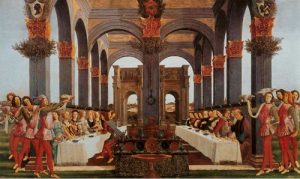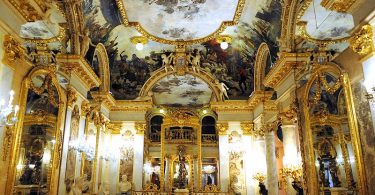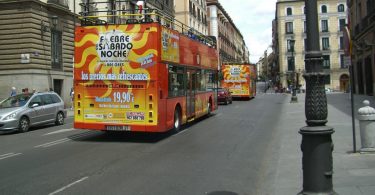The Prado is famous for some of the most beautiful and inspiring paintings ever made but it houses also s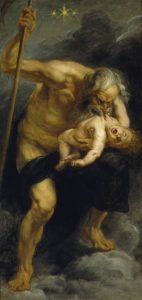 ome of the darkest scenes ever put on canvas before. Some of these works were made by painters who expressed their inner turmoil through their works while others were more inspired by Greek or Roman mythology.
ome of the darkest scenes ever put on canvas before. Some of these works were made by painters who expressed their inner turmoil through their works while others were more inspired by Greek or Roman mythology.
Painter Pieter Paul Rubens got his inspiration from an old roman poetry book called Metamorphosis written by poet Ovid which tells the story of the Titan Cronus (in the title Romanised to Saturn), who, fearing that he would be overthrown by one of his children, ate each one upon their birth. On Rubens painting Saturn Devouring His Son (1636), you can see one of Rubens most violent and shocking scenes from of all his oeuvre. The painting was originally painted to decorate the Torre de la Parada in Madrid, a hunting pavilion from Felipe IV, who had ordered several paintings from Rubens to decorate this royal estate located in the o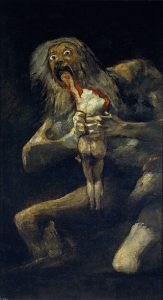 utskirts of Madrid.
utskirts of Madrid.
Francisco Goya probably got his inspiration from the Rubens painting but made a slightly different version of his Saturn Devouring His Son (1820), instead of painting a young child, Goya turned the victim into mature son, already decapitated on the scene. Word said that the Saturn on Goya´s painting was, besides being depicted extremely mad, also X-rated as there is evidence that Saturn was originally portrayed with an erect penis on the horror scene. His member probably has been faded out though when the painting was transferred from Goya´s wall in his house to canvas, or it just got over painted before the picture was put on public display in the Prado.
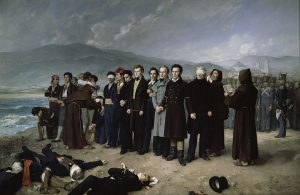 A more contemporary real scene that took place in Malaga is The Execution by Firing Squad of Torrijos (in Spanish Fusilamiento de Torrijos) painted by Antonio Gisbert in 1888. This former Prado director was also a painter himself and got commissioned to paint this work for the liberal government that would use it as an example of the defence of freedom for future generations. The painting shows the execution of Captain and General José María de Torrijos y Uriarte when he gets fusilladed by the troops of Fernando VII on the beach of Malaga in 1831.
A more contemporary real scene that took place in Malaga is The Execution by Firing Squad of Torrijos (in Spanish Fusilamiento de Torrijos) painted by Antonio Gisbert in 1888. This former Prado director was also a painter himself and got commissioned to paint this work for the liberal government that would use it as an example of the defence of freedom for future generations. The painting shows the execution of Captain and General José María de Torrijos y Uriarte when he gets fusilladed by the troops of Fernando VII on the beach of Malaga in 1831.
Sandro Botticelli got his inspiration from an Italian tale written by Giovanni Boccaccio (1313–1375) from his famous book The Decameron (Italian: Decamerone) and painted The story of Nastagio degli Onesti (1483) which first gives the impression of an absolute horror scene that takes place in the forest. The complete painting consists of four panels of which three can be found in the Prado museum and the fourth in a private collection in the USA. Completed in 1483, the paintings were com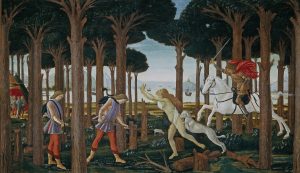 missioned by Florentine Lorenzo de’ Medici to mark the occasion of the wedding of his godson.
missioned by Florentine Lorenzo de’ Medici to mark the occasion of the wedding of his godson.
The story is about Nastagio, an Italian young man from Ravenna who is rejected by his fiancée and the woman he loves and has abandoned the city to reset his mind in the outskirts. In the woods, he encounters a terrifying scene of a naked woman who is hunted down by a knig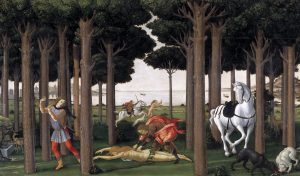 ht on a horse and a mastiff (the first painting) of which Nastagio tries to defend with a tree branch.
ht on a horse and a mastiff (the first painting) of which Nastagio tries to defend with a tree branch.
On the second painting, we can see an even crueler scene when Nastagio watches in horror as the knight captures the woman, tears out her heart and feeds it to his dogs. Nastagio is horrified with the scene but in the story of the Decameron the woman suddenly gets to her feet, starts running again and the knight and dogs start the chase again (painting two).
Nastagio then realises that he has witnessed a phantom hunt or an ongoing curse, which serves as a lecture to him about love and the rejection of his fiancée. The curse teaches Nastagio that he still can convince his fiancée to marry him and he invites her and her family for a picnic in the forest so they all can witness the ongoing curse. Nastagio does this with the hope that his fiancée in the end still will agree to marry him, which on the painting can be seen in the background, as a servant approaches Nastagio with a message from the lady saying that she will agree to marry him in the end (third painting).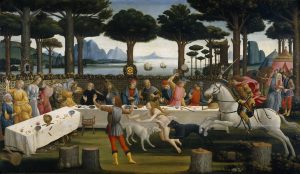
The fourth panel, owned by a private collector in the USA, entitled The Wedding Banquet, shows the splendid wedding celebration set under a magnificent archway. The guests are seated at tables; Nastagio and his lady sit at the head table. The coats of arms in the painting are of the Pucci and Binni families, an allusion to their own wedding on which occasion the paintings were commissioned.